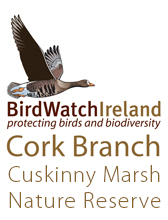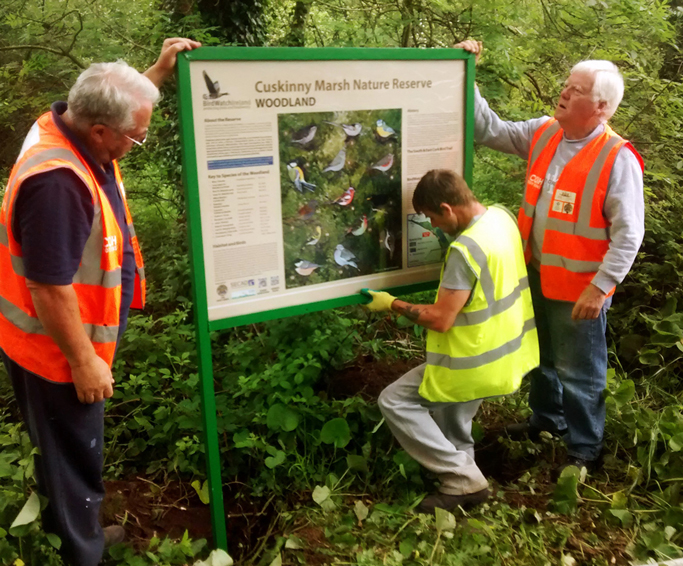Education
The reserve is used by Scoil Iosaef Naofa, a primary school in Cobh, for natural history teaching purposes. Over the past twelve years up to 500 pupils have visited the reserve in an organised and supervised way. Individual visits are normally limited to 5/6 pupils, accompanied by their teacher and the reserve warden, to minimise impacts to the reserve. The school’s activities include a nest box monitoring scheme and monitoring of water levels in the lake. The nest box monitoring scheme includes construction and maintenance of the nest boxes, and recording the use of the nest boxes as part of the BTO nest record scheme. This scheme began in 1990 with nine nest boxes and currently has 23 nest boxes. The monitoring of water levels was carried out between 1991 and 1996. Water levels in the lake were compared with rainfall, recorded at the school. The reserve is also used for general natural history education and in 1995; the school had a project on the reserve displayed in Cobh Library. The school’s involvement in the reserve has also stimulated involvement in other natural history activities, such as pupils participating in BWI’s Winter Garden Bird Survey. In 1993, the reserve was used as a fieldwork site for Adult Education students attending the Field Ecology course run by the Department of Adult and Continuing Education of University College Cork. In 1994, 4th year students on the Applied Ecology BSc course run by the Department of Zoology and Animal Ecology of University College Cork used the reserve for fieldwork. Other groups, which have visited the reserve on guided visits, include local BWI branches, Summer Camps, Boy Scouts, Sea Scouts, Girl Guides and the Douglas Boys Brigade. Cuskinny Bay is used for educational fieldwork by St. Mary’s Convent Primary School, Cobh.
The main interpretation facilities for the reserve are information boards first erected by BirdWatch Ireland in the early 1990’s and then updated with financial assistance from ECAD in 1999, as part of the East Cork Bird Watching Trail. At the bay, there is one board providing general information about the site including a synopsis of its history, and another board providing an illustrated key to the bird species likely to be seen in the bay. At the bird feeding area, there is a board providing an illustrated key to the bird species likely to be seen on the lake. In 1995, a leaflet was produced describing the main tree species of the reserve. Name plates were installed under representative specimen trees along the roadside section of the reserve, creating a nature trail.
Research
In 1991, the lake was used as one of 13 sites in a study of the ecology of lagoon habitats in Cork and Wexford. This study was carried out for a MSc dissertation at University College Dublin (Galvin, 1992). In 1995, the reserve was included in a lichen/baseline air quality survey of the Cork Harbour area. In 1996, the lake was surveyed as part of a national survey of lagoon sites, commissioned by the Dúchas (Healy et al., 1998). The purpose of this survey was to identify the most important lagoon sites in the country so that they could be designated as Special Areas of Conservation under the Habitats Directive (92/43/EEC). There are no specific facilities for scientific research at the reserve but it would be great to develop facilities for research in the future. Students from University College Cork have used the reserve for a number of research projects and we wlecome any proposals for any research projects within any of the fields of science etc.
Environmental Science undergraduate and postgraduate projects on Cuskinny Nature Reserve
Undergraduate projects
Nienke van Hest 2004 Conserving nature in Cuskinny Lake: proposals for restoration of Cuskinny Lake and its surroundings.
Susan Lettice 2007 The impact of salinity on the growth and distribution of Petasites fragrans at Cuskinny Marsh Nature Reserve, Cobh, Co. Cork
Noel Howley 2008 Invertebrate ecology of three coastal saline lagoons in Co. Cork: overview of diversity, species abundance and sampling techniques.
Postgraduate projects
Susan Lettice PhD project 2007–2011 Analysis of flora and fauna in relation to salinity levels in Irish lagoons in order to create a baseline for determining the impact of global climate change (provisional title)
Conservation
The earliest interest in the reserve as a site of ecological interest appears to have been the start of regular bird recording in 1972. Apart from this, there appears to have been no scientific or ecological interest shown in the reserve site, prior to the establishment of the nature reserve in 1990. The reserve site was not included in the Area of Scientific Interest designations (AFF, 1981; WS, 1989), and is not referred to in Goodwillie (1986).
Present conservation status.
Separate management agreements between Birdwatch Ireland and the two landowners established the nature reserve. The first management agreement (with Mr. John Ronan) was signed in January 1990, and the second management agreement (with J.A.D. Bird) was signed in August 1992. The reserve has been proposed for designation as a Natural Heritage Area (Site Code 01987) by the Dúchas. The pNHA includes all of the reserve, plus two small additional land parcels, but excludes the bay (see Figure 2.9). NHA’s will be designated under the forthcoming Wildlife Act (Amendment) Bill. The County Development Plan: South Cork (CCC, 1996) has designated the reserve and adjoining hillsides as ‘Agriculture/Forestry (Objective: Protect Scenic Landscape)’ Public interest The reserve is well known locally and has received publicity in local and national media. The main users of the reserve fall into three groups: general visitors, local schools and bird watchers and other naturalists.
Management actions
The boundaries of the reserve have been broadly delimited by erection of signs (see Section 2.1.3). Interpretation boards have also been erected Artificial rafts have been installed in the lake. A number of different types of rafts have been used, with varying degrees of success. All the rafts are used regularly by gulls (all species) and Cormorants and occasionally by Moorhens, Mute Swans, Grey Herons, and Sandwich Terns.
Artificial rafts.
In 1993 one raft of ‘RSPB’ design – railway sleepers, plastic coated chain link fencing and polystyrene blocks, covered with boulders and rocks from north end of lake. Three duck nest boxes were put on this raft. Mallard nested annually for seven years and Shelduck hatching young on two occasions.
In 1997 another raft was installed using 40 gallon plastic drums as flotation, 3″ angle iron frame with chain linked fencing and builders plastic, and covered with sand and shingle from the bay. Tern decoys were erected and Common Terns visited briefly in the following spring. Gulls use it for roosting and loafing, and attacked and destroyed tern decoys. In 1998, a pair of Black-headed Gulls were seen displaying on a few days in May 1999. In 2000 another raft of the same design as the 1993 raft, but covered in sand and shingle was installed. Seven tern decoys were erected and like the previous ones all decoys destroyed.
Artificial Shore line.
As the lake is not natural there is no shoreline of any description. This reduces potential for the use of the reserve by migrating waders. A section of around 8 m of artificial shoreline was installed in March 1990 on the northern shore of the lake. This involved removing the existing vegetation, placing a double layer of builders plastic 2 m wide along the waters edge and covering this with a thin layer of 2″ hardcore. Black-tailed Godwit, Wood Sandpiper, Green Sandpiper, and Common Sandpiper have all occurred on this shoreline, although only the latter species has occurred on a regular basis. The shoreline has also increased the number of Water Rail sightings.
Other management activities
In 1991, twenty Alders were planted by the Gorse patch in the meadow area south of the lake. A small pond of c. 20 m diameter, incorporating a small central island, was excavated in the woodland area to the north of the lake in August 1993. A new plant species for the reserve, Celery-leaved Buttercup, was discovered around the pond the following summer. Three species of Dragonfly have occurred on the pond. This pond has attracted nesting Mallard, Moorhen and Teal (and up to 12 Teal in winter).
The pond has also proved to be a good habitat for damsel flies and dragonflies.
Recreation
The main recreational users are probably visitors and local people enjoying the general amenities of the area. The other type of recreational users is bird watchers. The number of recreational visitors has been estimated as 8,000-10,000 per year. This figure is based upon many half-day observations of people either walking (recreational) or feeding the swans. The only active type of recreational use to directly affect the reserve is feeding wildfowl, and a section of the lakeshore adjoining the Tay road has been made accessible for this purpose. A footbridge over the roadside ditch has been provided, and a litterbin has been installed here. The roads are used as amenity walking routes. The quay provides car parking space and views out across Cork Harbour. The reserve is mentioned in Where to Watch Birds in Ireland (Hutchinson, 1994), is included in the East Cork Bird watching Trail, and is well known by local bird watchers. The main interest for keen bird watchers would be in winter, to check the lake for rare gulls. For the more general bird watcher, the lake provides a convenient location for seeing common wildfowl species. The inclusion of the reserve in the recently established East Cork Bird watching Trail (ECBT) is likely to increase the number of visiting bird watchers. The ECBT is a signposted trail to bird watching sites in East Cork, and glossy leaflets distributed through tourism outlets promote the trail. The interpretation boards at the reserve have been provided as part of the ECBT. There is no right of public access on to the reserve lands, and most of the reserve is not easily accessible to casual visitors. The grassland at the southern end of the reserve is, however, readily accessible from the road.
In 2011 Jim Wilson made a presentation to Cork County Council with a view to increasing the safety of visitors to the reserve by proposing traffic calming measures between the northern limit of the reserve at the bottom of Bird’s Hill and the Car Park at the Bay. Local councillor Sean O’Connor arranged the meeting. This led to some signs being erected. Unfortunately this has not had any real effect on the speed at which cars travel on the short stretch of road. The ultimate goal would be to create a Pedestrian Priority Area along this stretch of road ( in co-operation with local residents). We believe this would make the area safer for everyone using it and enhance it as an amenity. Click on the link to download the Cuskinny Pedestrian Area Presentaion. At the end of the proposal Jim also suggests a series of walking trails starting and finishing at the car park at Cuskinny. This would add to the amenity and tourism value of the island.




